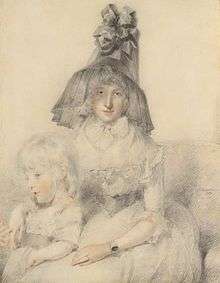Charlotte Papendiek
Charlotte Louise Henriette Papendiek (née Albert; 2 July 1765, London – 24 April 1840, Windsor) was a lady-in-waiting to Charlotte of Mecklenburg-Strelitz, consort to George III of Great Britain.

Life
Charlotte was the daughter of Friedrich Albert (born 28 January 1733, Frankfurt am Main), who in 1755 had entered the service of Adolphus Frederick IV, Duke of Mecklenburg-Strelitz. When Adolphus Frederick's 17-year-old sister Charlotte married George III in 1761, Friedrich Albert followed her to Britain as a page, barber and hairdresser. Friedrich's daughter Charlotte married Christopher Papendiek, a violinist, flautist and court musician to George III, on 16 January 1783 in St George's Hanover Square.[1] They had six children, including the diplomat and painter George Ernest Papendiek (1788–1835) and the architect Charles Edward Ernest Papendiek (1801–1835)
On 16 October 1794 she became Assistant Keeper of the Queen's Wardrobe [2] and she later also became Queen Charlotte's reader. In 1833 Charlotte Papendiek began to write an extensive set of memoirs – they remained unfinished and were published by her granddaughter in 1887. Alongside the diaries of Fanny Burney, another lady-in-waiting, they are a major source on family and artistic life within the British court at that time. They also contain much information on musicians active in London at this time, such as Johann Christian Bach, George Bridgetower, Muzio Clementi, Joseph Haydn and Johann Peter Salomon, and were used as such by Rita Dove for her Sonata Mulattica on Bridgetower's life.
Works
- Court and Private Life in the Time of Queen Charlotte: Being the Journals of Mrs Papendiek, Assistant Keeper of the Wardrobe and Reader to Her Majesty, edited by her Grand-Daughter, Mrs Vernon Delves Broughton, 2 volumes, London: Richard Bentley & Son, 1887
- Vol 1 (Digitised version)
- Vol 2 (Digitised version)
- Michael Kassler (ed.), The Memoirs of Charlotte Papendiek (1765–1840), London: Pickering & Chatto, 2015
References
- See also F. Anne M. R. Jarvis, The community of German migrant musicians in London c1750 – c1850, Cambridge 2003 (online)
- Michael Kassler (ed.), The Diary of Queen Charkotte, 1789 and 1794, London, Pickering & Chatto, 2015, p. 281